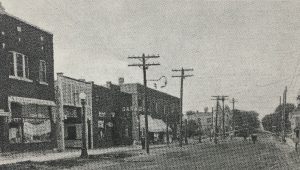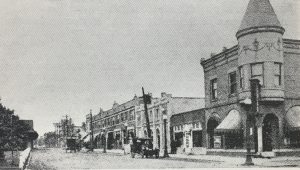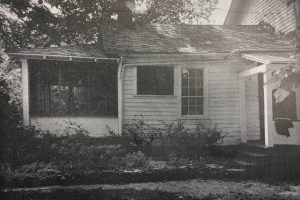The Early History of York Township
The first surveyor arrived in 1780 to survey the territory and the first settlers came in 1830.
“The history of township government in this area goes back to the year 1787 when the Northwest Ordinance was passed by the Continental Congress. It directed the governor of the Northwest Territory to lay our counties and townships and then appoint magistrates and other civil officers in these units. In 1818 when the State of Illinois entered the Union; the townships were larger in area and in irregular shapes.” (Hunter, 1975)
York was first settled in 1834 by Elisha Fish when he purchased the south east quarter of section thirty-five on the west bank of Salt Creek as his new home. Although many say it was settled in 1830, no records of their names or date of settlement can be found. Henry Reader took the south-west corner of section thirty-five in 1835. Luther Morton, Benjamin Fuller and Nicholas Torode all settled on parts of section twenty-seven that same year. In 1836, John Talmadge moved from Brush Hill to York and settled on the south east quarter of section twenty-three. 1836 brought several families to York including Jesse Atwater, Edward Eldridge, Jacob W. Fuller, David Talmadge and David Thurston. Then in 1837, Sheldon Peck, W. Churchill, Zarais Cobb, John Glos and John Bohlander settled in York on what is now called St. Charles Road. John Thrasher settled in section thirty in 1837 as well. John was a soldier in the U.S. Army and was in service during the War of 1812. These men moved out west onto land ceded by the Indians when the government opened the land to settlers under the preemption laws which enabled pioneers to stake a claim at $1.25 an acre.
These hardy and daring pioneers planted crops and built homes on their newly acquired property. It was said that York had an “agreeable variety of surface and soil, and with proper cultivation, yields him most bountiful harvests”. (DuPage History, 1857) Also, helping to make York a desirable location to settle with your family was the Salt Creek stream that runs through town from north to south.
A steam flouring mill was in operation at Brush Hill, owned by F. Gray. The mill was the only manufactory at the time and was very important to the town. The old saw-mill on Salt Creek burned down in 1848 and in 1852 a grist-mill was built in its place by Fred Graue and W. Arche. Graue Mill still stands on York Road just north of Ogden Avenue.
The Galena Railroad was built running through the town with that two young and thriving villages sprung up, Cottage Hill and Babcock’s Grove. “The village of Cottage Hill is pleasantly situated on the line of Galena and Chicago Union Railroad, sixteen miles west of Chicago. The first settler here was J.L. Hovey, who came from Painsesville, Ohio. He built a small house in 1843, which he kept as a hotel, it being favorably known by the farmers of the Fox and Rock river counties, who then teamed their own produce to Chicago, as the ‘Hill Cottage.’ The ‘Hill’ proper lies half a mile from the railroad, and commands as fine a prospect of prairie, cultivated farms, groves, cottages, and railroad trains as one could desire to behold. This place but 15 ½ miles from the center of business in Chicago; having good water, pure air, and railroad trains hourly passing – all of which stop here – must soon become known to those who would find for themselves and families, at a convenient distance from the city, a retreat from the noise and dust of its hot and crowed streets.” (DuPage History, 1857) By the time the railroad was completed in 1849 the village had one hotel, five stores, several manufacturing establishments, a railroad passenger house, thirty to forty dwellings, and about 200 residents that called Cottage Hill Home. And construction was under way to build a new building to be used as a church and school house.
The village of Babcock’s Grove, situated about five miles west of Cottage Hill on Galena Road also had around 200 residents. It was considered a pleasant village and an active, businesslike place. There was one hotel, several stores and several residences built by 1849.
In 1848 a new constitution was passed and in 1849 a law was passed providing for the township as an election precinct, and provided for the formation and election of its officers. York Township was organized in the spring of 1850. At that time there were only 9,290 people living in the county of DuPage. York Township took its name from the State of New York as our first settlers were from there.
The first town meeting was held “on the second day of April being the first Tuesday in April in the year of our Lord one thousand eight hundred and fifty, for the purpose of electing town officers in and for said town, for the ensuing year and for the further transaction of such.” (Township Records, 1850) The meeting took place in the home and tavern of Gerry Bates called Hill Cottage Tavern. The meeting was organized by appointing John Talmadge, Moderator and Edward Bonney, Clerk. After both men were sworn in a proclamation was made by the Moderator that the meeting was organized and ready to receive votes for several town offices, as prescribed by law. There were 101 men who attended the first meeting and voted for the new officers. Elected that night were Edward Eldridge, Supervisor; Allan M. Wright, Clerk; George Fuller, Assessor; Adam Glos, Collector; Robert Reed, Overseer of the Poor; and John Thrasher, Highway Commissioner.
The meetings of the Board of Trustees, as well as the Annual Town Meetings, were held in the various Board Members’ homes. Church services were also held in the various homes in the early days of York Township. John Talmadge, moderator of the first Town Meeting, accommodated the first church service in his home, at which an itinerant Methodist minister, Rev. David Colson, did the preaching.
According to an 1850 map of Cook and DuPage Counties, a road passed through York Township leading from Chicago to St. Charles, with just one or two smaller roads.
Gerry Bates moved from Ohio in 1842 and purchased a treeless track of land between North Avenue, York Street and St. Charles Road, and a line a half mile west of York Street. He had his brother-in-law, Darius A. Hovey build him a home on his property on the north side of St. Charles Road, just east of what is now Cottage Hill Avenue. The house was complete in 1843 and named Hill Cottage. The house served as his family home and as a hotel and tavern. In 1845 Hill Cottage also served as the post office. This building was moved in 1906 to 413 South York Street near Orchard and became a private family home. “The floors of the building are pegged with wooden pegs, and the ceiling are carved plaster, with fireplaces in every room. The home and tavern were originally owned by the Gerry Bates family and was a stage station on the St. Charles plank road between St. Charles and Chicago.” (Thompson, 1982) Mr. Bates gave a right-of-way to the Galena and Chicago Union Railroad in exchange for a station to be built opposite his home on Park Avenue, west of York Street. Many of the 1871 Chicago Fire homeless victims were evacuated to Elmhurst and the Bates home was one of those giving refuge.
Cottage Hill became the Village of Elmhurst in 1869. The name change was due to being confused with places with similar names, Cottage Grove and Council Hill for example. Thomas Barbour Bryan suggested the name Elmhurst, meaning forest of elms. On April 11, 1910, Elmhurst was incorporated as a city.
In 1871 Elmhurst College was founded, known as the Elmhurst Troseminar of the German Evangelical Synod of North America, with just twelve students and one teacher.
Lombard was known as Babcock’s Grove and in 1851 had five frame houses, and one store, besides the building owned by the Chicago & Northwestern Railroad, which was both a depot and hotel. Babcock’s Grove became incorporated as the Village of Lombard in 1869.
The population of the Town of York was almost 1,500 by 1857. “The Germans had settled pretty thickly in some parts of the town, and among them may be found some of the best farmers in the county. They are frugal, industrious, and honest, as a class, and manage their farms with superior agricultural still.” (DuPage History, 1857) At this time the town has three post offices; George Fuller was post master at York Center, Gerry Bates at Cottage Hill, and J.B. Hull at Babcock’s Grove. York also had the largest school fund of any town in DuPage County. The school section was sold at $5.00 per acre, creating an original fund of $3,200. The highest rate of compensation paid to teachers was $25 per month; the lowest was $10. The annual amount paid for teachers’ wages was about $800. There were eight public schools in the township with about 400 students. School was taught eight months out of the year and the average number of scholars in each school was forty. York had come a long way since Public School District No. 1 was organized in 1850, with 1 little 20’x24’ structure in the rear of Peter Torode’s house at 331 South York Street in Cottage Hill.
Mammoth Spring burst through the earth’s surface in the spring of 1861, making a loud report. The spring located in the highway between lands owned by G.H. Talmadge and Robert Reed and has many peculiarities, one being it was reported to possess many medicinal properties. And in 1874 York Township was hopeful it would become a famous place of resort.
In 1866 The First Church of Christ was organized by Rev. James Tompkins with fourteen members. The house of worship cost $9,000 to build. In 1870 a division occurred and ten members withdrew and formed a new church they named First Congregational Church. In 1871 they built a new church at the cost of $5,000. In 1873, a new organization formed and embraced the two churches under the name of the First Church of Lombard. There was also a German Lutheran Church located at York Center and one mile south the Methodist Society also had a church organization and building. The German Evangelical Pro. Seminary was founded in 1870 by the German Evangelical Synod of the West and was run by Prof. Charles Kranz. Kranz was also pastor at the United German Evangelical Church that was organized in 1873 and held service in the college chapel. Mr. Thomas B. Bryan built a church on his property near his residence in which service was regularly held however, there is no mention of the demonization.
In 1875 Louis Frederick Backhaus and Friedrich Brockmann purchased a ten-acre farm located in section 21 for $900. Section 21 is the property that 100 years later Town Hall would be built at the corner of Meyers and 16th Street. In the northwest corner of the property they built a windmill which they named Dutch Mill. The windmill’s structure was made from a Dutch-build prefabricated kit that included had-cut cypress beams with hickory and maple gearing. The parts were shipped to the township and assembled on site. The mill also has a wing building presumably used for storage (though it may have once housed an auxiliary steam engine). Business for the mill was relatively good, probably because of its location to the railroad line (now the Illinois Prairie Path). However, storm damage lead to the October 15, 1914 sale of the mill to Colonel George Fabyan for $8,000. Fabyan is said to have purchased the mill as a gift for his wife. The mill was shipped to Geneva and reassembled on the riverbank of the Fox River on the Fabyan estate. Completely refurbished and operational the Fabyan windmill still stands on what is now park of the Kane County Forest Preserve District.
York Township encompasses the Villages or Cities of Elmhurst, Lombard, Villa Park, Oak Brook, Oakbrook Terrace and small portions of Downers Grove, Westmont, Hinsdale, and Glen Ellyn.
The History was compiled using the following
Township Record Books starting April 2, 1850
John Hunter, Clerk 1975 Annual Town Meeting speech
Kezia E. Thompson, Clerk 1982 Annual Town Meeting speech
A History of DuPage County, Illinois, 1857



